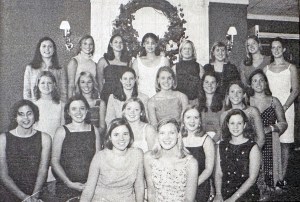The Town Crier: City limit limits (part 1)
Published 2:00 pm Sunday, July 30, 2023

- The Town Crier
Well, they’ve finally done it. They’ve enlarged, annexed and added on to the city of Dalton so that when looking at the current map of the city limits I can no longer spot any place I can discern as part of the original city limits from the first layout of Dalton in the mid-1800s.
You may or may not know, but Dalton was originally a circle. When the railroad survey team came through and it was made known that the tracks were passing close to a little hamlet known as Cross Plains, some future-looking folks got together and said, “We’re going to build us a town here!”
Trending
They placed a marker right in the middle of the depot and declared it the center of town. Then they declared that one mile in each direction from that marker would be the city limit for the new town of Dalton, Georgia.
There’s still a marker right there in the old depot downtown, and as soon as somebody opens it up again you can go look at it. and FYI, for the railroad, the mile marker in Dalton is the 99 mile marker from the zero mile marker in Atlanta where the railroad begins.
The circle of Dalton city limits meant that from one side to the opposite of the city would be a two-mile walk. I usually walk that far in Walmart each trip shopping. With the schools located in the central portion of town, I was told that’s why there was no school bus service for city schools until the mid-1970s; they figured a kid could walk a mile to get to school and back.
Just a few years ago I looked at a map of Dalton and there were still some sections where parts of the circle were still visible. and from those you could use your compass (not the magnetic directional device, the thing you used in geometry with a pencil in one side and the other side a sharp point that they probably don’t allow in schools anymore), and you could trace exactly where the original line was. Alas, no more.
If you look at a map of Dalton city limits now you’ll see it’s a checkerboard of varying squares attached to each other like a kid’s stacked building block set, stretching from one end of the county to the other and from side to side. Throughout, there are islands of county here and there, patches and parcels that are not “city-fied.” The outlet mall at the end of West Walnut Avenue is half in/half out of the city.
No loopholes?
Trending
As our community grows and the city expands into the county and the county has multiple islands of land in the city limits, or in some cases, split by a road where one side of the road is Dalton and the other side is Whitfield County, there has been much work to make things more “unified.” One of these efforts is the unified zoning ordinance which includes Whitfield County, the city of Dalton and the city of Varnell. This is an effort to standardize various ordinances so that businesses, property owners and citizens will have a simpler way to work and live, without having a house or business on one side of the road having different requirements than the house on the other side. I notice Cohutta and Tunnel Hill are not on the document I was looking at, so if you want to build a 600-foot-high life-size model of Godzilla in your backyard and rent it out for children’s birthday parties, those two cities might be your go to.
Looking over the unified zoning ordinance document, the first thing I had to do was cover the list of definitions at the beginning, the part that lets everyone know what everyone else is talking about. Those politicians and lawyers have to break everything down with the idea of having everything covered and no loopholes. Light switches at the top and bottom of all stairs in the house? Check! Cemetery includes mausoleums? Check! Standard footage of field lines per bedroom in the house? Check! See? Easy!
Let’s start with some “assumptions” for words found in the document, because they don’t want anyone to be surprised. Please assume the following: Present tense words include the future tense also. Words in the singular include the plural and plural words include the singular. So if it says “bricks” and you build a house using only one “brick,” that’s covered. No loophole!
The word “structure” includes the word “building.” Sounds simple, but wait until we get to “structure” and “building” in the definitions. and if you’ve ever wondered if you’re a “person” or not, according to the definitions in the document, you are a person if you’re a “person, individual, firms, partnerships, corporations, associations, governmental bodies,” and all other similar legal entities. My dog and the dog next door have an “association” based on lying around on the porch and chasing the occasional squirrel, so maybe they’re a “person,” too!
Defaulting to Webster
Getting into the main part of the definitions of words used in the document, there are plenty of words useful for ordinances, but not every word is in there. In the event a definition is needed that’s not in this list, the definition defaults to the Webster’s Collegiate Dictionary. But you have to use the definition that is dealing with what’s being talked about. Let’s say there’s something in there about your airspace over your yard and the ordinance covers kite flying. If you show up in court with your kite but try and pull a fast one and use definition 3 where “fly” is slang for a zipper on pants, the judge will not be amused.
The list of words and phrases are in alphabetical order so we can skim down and see what’s what when it comes to regulations in Dalton, Varnell and Whitfield County. The first thing that caught my eye was that there are entries for “Bed and Breakfast Home” and “Bed and Breakfast Inn.” Turns out a B&B “home” must provide breakfast and overnight stay to people unrelated to the owner in no more than five bedrooms for no more than five nights.
An “inn” B&B can’t have more than 18 persons per night. Have I found a loophole already? The “home” limits the number of bedrooms, but the “inn” limits the number of people. Thinking back to camping trips and road trips with my buddies in “hi skool” and college, we could easily get 10 people in a room. That means we could cram 50 people (at least) in the B&B home while we would be limited to only 18 folks in the inn. Keep that in mind before you book online.
Still in the “B’s,” we come to “berm” which is (noun) a mound of earth or (verb) pushing dirt into the form of a mound. Berms are used in building a “structural zoning buffer,” which is covered later. The most famous berm I know of is the railroad track that runs around Disney World. The berm was made and the track placed on top to act as a sight and sound barrier to the outside world for the folks inside the Magic Kingdom. Other zoning buffers can be natural, like evergreen plants such as magnolia or pine trees, or a curtain of bamboo, acting as a type of visual curtain between properties. The structural buffer is a man-made curtain that can be a wall, a berm or fence to act as a visual buffer.
Did you know you or your organization, whatever it is, can have a “private camp”? Overnight accommodations can be provided as long as it’s related to the main purpose of the “fraternal, social, educational, recreational, cultural or religious” group. So for example, you could have a wilderness camp for the Brotherhood of Tea-Drinking Professors Who Play Ping-Pong Based on Ancient Aztec Methods Who are Lutherans. I looked that group up in the yellow pages, but I don’t think they actually have a camp yet.
I came across “convenience center” and mistook it for “convenience store,” which is right below it on the list. “Store” is like a Quickie Mart at the gas station. “Center” is where you take your own household garbage to drop off with the recycling. Please don’t get them mixed up like I did; you’ll be disappointed on both counts.
For the definition of “debris,” please note that it includes such things as slag, brickbats, rubbish and refuse (all fun words to say), as well as, in what may be the most all-encompassing definition in the whole document, “discarded materials of every kind and description.” For all you readers who may be in the Mafia, this would seem to include any bodies of gamblers who refused to “pay up,” but maybe that’s a question for the Board of Zoning Appeals at their monthly meeting. I’d hate to steer you wrong.
Next week we’ll work our way on down the list.





